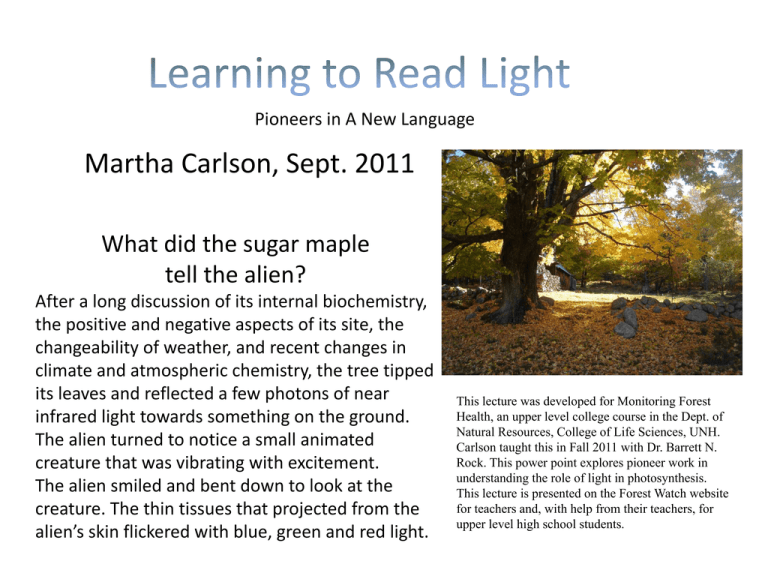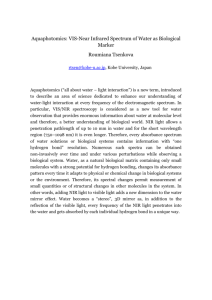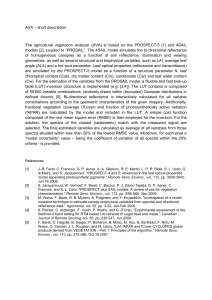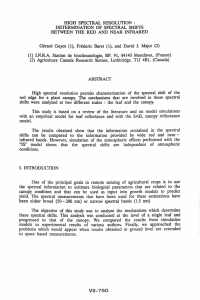Learning to Read Light
advertisement

Pioneers in A New Language Martha Carlson, Sept. 2011 What did the sugar maple tell the alien? After a long discussion of its internal biochemistry, the positive and negative aspects of its site, the changeability of weather, and recent changes in climate and atmospheric chemistry, the tree tipped its leaves and reflected a few photons of near infrared light towards something on the ground. The alien turned to notice a small animated creature that was vibrating with excitement. The alien smiled and bent down to look at the creature. The thin tissues that projected from the alien’s skin flickered with blue, green and red light. This lecture was developed for Monitoring Forest Health, an upper level college course in the Dept. of Natural Resources, College of Life Sciences, UNH. Carlson taught this in Fall 2011 with Dr. Barrett N. Rock. This power point explores pioneer work in understanding the role of light in photosynthesis. This lecture is presented on the Forest Watch website for teachers and, with help from their teachers, for upper level high school students. “What is it? It doesn’t reply,” the alien asked with surprise. “That’s a human. They don’t have very good receptors. They don’t light. They’re ilphotonic.,” the maple reflected. (By the end of this lecture, you will be able to define “ilphotonic”.) Gates et al. 1965 What is the relationship between light and plants? What makes plants grow? Heat? Light? “…the interaction of radiant energy with the plant leaf…” Shull, 1929, McNicolas, 1931, Rabideau, 1946—Step by step, scientists began unraveling the mystery. Dr. David M. Gates, a biologist at the National Bureau of Standards at the University of Colorado, experimented with spectroscopy and microscopy to find the answers. Gates measured the size of cells in leaves(15 microns x 15 microns x 60 microns), counting the chloroplasts—he counted 50 inside one palisade cell. Gates’ New Concepts • The Energy Environment! “The energy absorbed selectively at certain wavelengths by chlorophyll will be converted into heat or fluorescence, and converted photochemically into stored energy in the form of organic compounds through photosynthesis.” Anatomical Ideas • The cells of the leaf are designed to receive maximum light. • The anatomical structures respond to light as in: Stomatal openings seemed to be connected to light. And leaves absorbed light along a light “action spectra”. Gates Noticed Differences Among Plants Cactus—Reflect more Lichens—Wet and dry Conifers—Design of needles, holding heat? In Visible Light Different reflectance and absorption of light with different: • • • • • Angles Wetness or Dryness Age of Leaf Pigments Species Different Wavelengths • Green is Different • Red is Different, changing as leaf grows • Discovers the Red Edge Inflection Point. • The REIP changes with growing leaf as more chlorophyll is developed. Near Infrared Light • Differences in NIR reflectance might be a function of cell shape, size and amount of intercellular space. • Thicker leaves have greater reflectance. • Why is NIR so reflectant? (Gates doesn’t know about porphyrin ring size and photon lengths). Other Unanswered Questions Heat energy and light energy. Measuring both. Not sure about how the photosynthesis systems dump heat. Fluorescence at a slightly longer wavelength—how does it work? Photons Are Fast and Very Small Mini-Lesson before we proceed: There are more femtoseconds in 1 second than there are seconds in 30 million years! 1 year= 31,536,000 sec. so 30,000,000 x 31,536,000 =9.4608 x seconds in 30 million years! th 1/1,000,000,000,000,000 , -15 1/10 14 10 or 946,080,000,000,000 part of one second in which a photon is absorbed! Femtosecond. 1 billion = 1,000,000,000 1 million = 1,000,000 Time: Femtosecond 10-15 billion millionths -12 Pico second 10 million millionths -9 Nano second 10 billionths Microsecond 10-6 millionths -3 Millisecond 10 thousands One second 1 1 Reading Spectral Analyses NIR 1 REIP NIR3 Sample VIRIS, September 15, 2008 90 Leaf Pigments Tree 835 Tree 812 80 70 20 NIR, TM5 NIR, TM4 30 Red Light, TM3 40 Green Light, TM2 50 Blue Light, TM1 Percent Reflectance 60 Water 10 0 400 600 Blue Green Red Visible Light 800 1000 Near Infrared Light 1200 1400 1600 Wavelength (nm) 1800 2000 2200 2400 NIR 1 REIP NIR3 Sample VIRIS, September 15, 2008 90 Leaf Pigments Tree 835 Tree 812 80 70 20 NIR, TM5 NIR, TM4 30 Red Light, TM3 40 Green Light, TM2 50 Blue Light, TM1 Percent Reflectance 60 Water 10 0 400 600 Blue Green Red Visible Light 800 1000 Near Infrared Light 1200 1400 1600 Wavelength (nm) 1800 2000 2200 2400 What are Nanometers? Micrometer one-millionth of a meter, 6 10 9 Nanometer one-billionth of a meter, 10 Gates calls it a milli micrometer. So to change 1.65 micrometers to 1650 nanometers, MOVE DECIMAL 3 spaces. Rock et al., Remote Detection of Forest Damage, 1986 Purpose of Research: “This…may allow scientists to discriminate and identify unique spectral signatures associated with the response of vegetation to various stress agents…spectral ‘fingerprints’ associated with specific causal agents of forest damage and decline.” Dr. Barrett Rock is the founder of Forest Watch. He is a professor of Natural Resources at the University of New Hampshire. New Concepts • Remote sensing can “see” the forest. • What Thematic Mapper, aboard Landsat satellite, 500 miles above Earth, sees can be the same as leaf reflectances in the lab. • Stress changes the absorption and reflectances of light. • Those changes in light disclose changes in anatomy and pigments Visible Light Confident about what blue, green and red light show. The red edge “is directly correlated with leaf chlorophyll concentrations”. The REIP changes with health and with normal senescence. Concentrations of pigments will vary according to stress. Infrared Light • NIR tells about leaf health, refractions along cell-wall-water-air interfaces. • Stress leads to less reflectance in NIR plateau. • Water content may be seen in SWIR area. Sensing Tools Some spectrometers cannot detect enough detail to see the blue shift in the REIP. Satellite imagery can be displayed in “false color composites.” What Do We Know Now Why does a leaf reflect NIR—porphyrins, photons are too long and slow waves. Fluorescence—a non-photochemical quenching of light energy—photoinhibition --not energy dependent (as carotenoids dump heat) and not a state transition (as antenna detach). Indication of activity in chlorophyll. Still mulling over the differences between temperature and light energy. See Morton (my body produces 3x its weight in ATP on an average day!) Today we are inside those chloroplasts and know that there are 600 million chlorophyll molecules in each chloroplast. In one square cm of grass, you would have more than 30 million chloroplasts! A single palisade cell with chloroplasts (Photosynthesis.com). What Do We Know Now • More information about structure of PSII and PSI and how they respond to stresses and how they are damaged by stress. • Rock’s “water stress index” recognized as TM5/4. • New satellites will measure fluorescence. • Still working on REIP. What Can These Two Papers Tell Us about Stress in Trees Today? Today scientists know about 80 “indices” or messages in light waves which they can interpret to understand tree health. We are trying to learn more of the language of light, to become as “photonic” as we are “literate.” Copyright 2011 University of New Hampshire.







